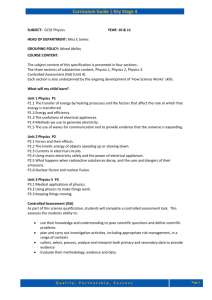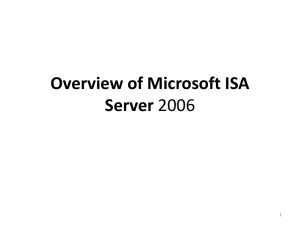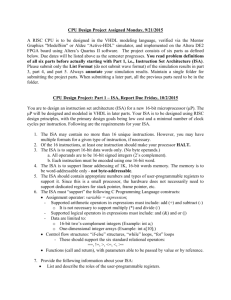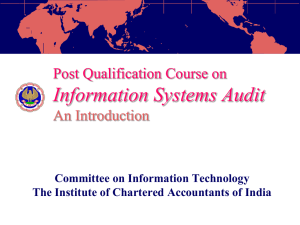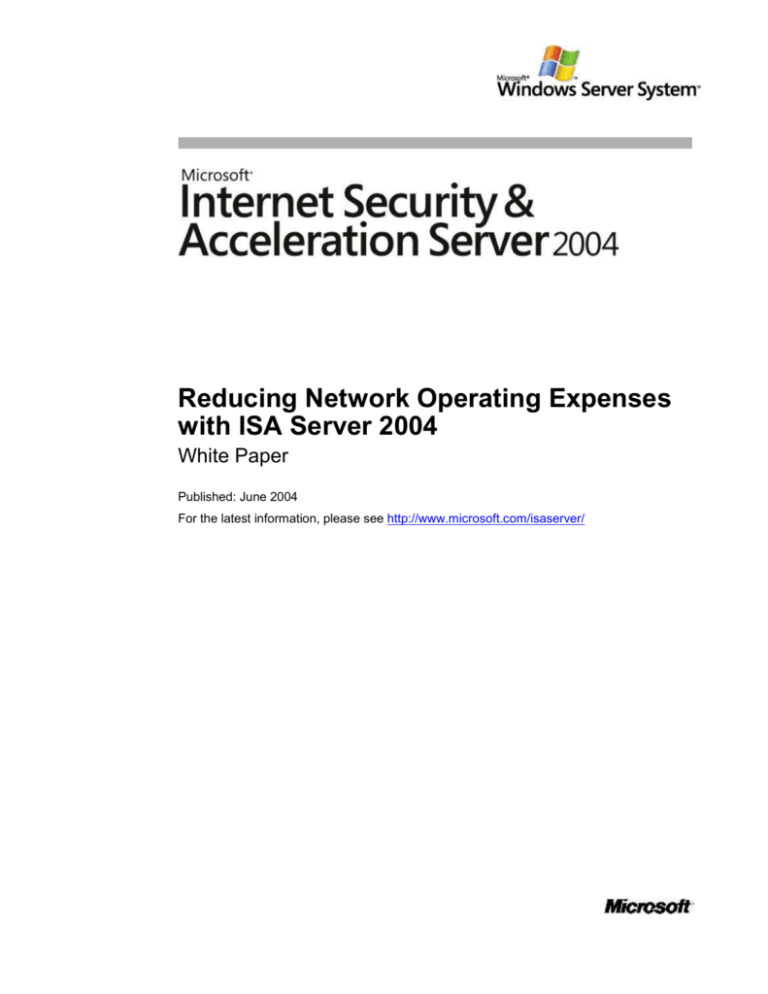
Reducing Network Operating Expenses
with ISA Server 2004
White Paper
Published: June 2004
For the latest information, please see http://www.microsoft.com/isaserver/
Contents
Introduction .................................................................................................................................1
Cost Benefits of Replacing Point-to-Point Leased Lines with ISA Server 2004
Site-to-Site VPN Networks ..........................................................................................................2
Scenario 1: Immediate Cost Savings Realized by Switching from Dedicated
WAN Links to ISA Server 2004 Site-to-Site VPN Connections ..............................................2
Cost Benefits of Employing ISA Server 2004 Web Caching at Branch-Office
and Main-Office Networks...........................................................................................................4
Scenario 2: Immediate Cost Savings Realized from Use of
ISA Server 2004 Web Caching...............................................................................................5
Cost Benefits of Combining ISA Server 2004 Firewalls with
Microsoft Exchange Server .........................................................................................................6
Scenario 3: Projected Cost Savings Realized by Protecting
Exchange Server Machines with ISA Server 2004 Firewalls ..................................................7
Conclusion ..................................................................................................................................9
Introduction
With corporate networks being increasingly bombarded by Internet-based attackers, firewalls
are a necessity for today’s enterprise networks. In addition to the security risks posed by
external attackers, users inside the corporate network can also be a source of problems—
whether their security breaches are intentional or unintentional. Consequently, a good network
firewall must be able not only to protect the corporate network from inappropriate access by
external attackers, but also to prevent, or at least limit, attacks from internal threats.
While all security and network professionals understand that firewalls on the Internet and
network perimeter are a necessary part of a comprehensive defense strategy, they may have
difficulty explaining the potential return on investment that their organization can realize by
employing such firewalls. Consequently, upper management may see expenses related to
security as part of the “cost of doing business,” rather than appreciating the potential returns
on investment—both immediate and long term—that a strong security scheme can provide.
This white paper examines three related scenarios that clearly demonstrate how a sophisticated,
application-layer-aware firewall, such as Microsoft® Internet Security and Acceleration (ISA)
Server 2004, can provide not only peace of mind and business continuity, but also improve an
organization’s bottom line. These scenarios demonstrate the cost benefits of:
Replacing point-to-point leased lines with ISA Server 2004 site-to-site VPN networks
Employing ISA Server 2004 Web caching at branch-office and main-office networks
Using the ISA Server 2004 firewall to protect machines running Microsoft Exchange
Server
Each of these scenarios builds on the previous ones, generating both immediate and longterm reductions in the organization’s expenditures.
Reducing Network Operating Expenses with ISA Server 2004
1
Cost Benefits of Replacing Point-to-Point Leased
Lines with ISA Server 2004 Site-to-Site VPN Networks
Most enterprises have a main office and multiple branch or satellite offices. They typically
connect the branch offices to the main office with dedicated, point-to-point leased lines rather
than routing communications through the Internet. These WAN links provide highly reliable
connections but are often prohibitively expensive, representing a major part of the IT
department’s total annual budget.
An organization can significantly reduce its yearly IT costs by replacing dedicated, point-topoint WAN links with cost-effective site-to-site VPN connections. In contrast to expensive
point-to-point connections, which use either dedicated circuits or permanent virtual circuits,
site-to-site VPN links use the Internet as a transit medium and “virtualize” the point-to-point
connection with VPN technology. With this approach, both main and branch offices replace
expensive dedicated lines with Internet connections and then install VPN routers to route
information between offices over the public network through a secure VPN tunnel.
For site-to-site VPN connections to be a viable solution, they must be secure. Dedicated
leased lines are highly secure because the telecommuncations companies do not route traffic
through public networks: They stay within networks that are under their tight control. In
contrast, the Internet is a shared, public network that does not have a centralized commandand-control infrastructure. Therefore, any interoffice communication moving across the public
Internet must be secured by powerful data encryption so that, even if it is intercepted in transit
between the main and branch office networks, the interceptor cannot read it.
VPN solutions consist of two separate but intertwined technologies:
The virtual aspect. Machines participating in a VPN connection use virtual networking
methods to trick applications and services running on each machine to “believe” that the
machine is directly connected to the remote network. Consequently, the machines behave
as if they were on the same corporate network, when in fact they are hundreds or thousands
of miles apart and connected only through the Internet. Examples of virtual network
technologies include L2TP, PPTP, and IPSec tunnel mode.
The private aspect. VPN technology encrypts communications moving through the virtual
network tunnel to secure them from Internet intruders. Two commonly used encryption protocols are Microsoft Point to Point Encryption (MPPE), used by the PPTP VPN protocol; and
IPSec, used by the L2TP/IPSec and IPSec tunnel mode VPN protocols.
Microsoft ISA Server 2004 firewalls support site-to-site VPN connections using PPTP,
L2TP/IPSec, and IPSec tunnel mode VPN protocols.
Scenario 1: Immediate Cost Savings Realized by Switching from
Dedicated WAN Links to ISA Server 2004 Site-to-Site VPN
Connections
Note: Costs for dedicated WAN and Internet links vary significantly by location and by date of
purchase. The dollar values used in this scenario reflect average costs at the time of writing
from Southwestern Bell and August.net, two Internet service provider in Dallas, Texas.
This scenario deals with Cosoftcom, a large software development and distribution firm with a
central office in Dallas, Texas, and five branch offices located in different states throughout the
U.S. Each branch office has 500 employees that require computer access to resources at the
main office. The main office has 5,000 employees.
Reducing Network Operating Expenses with ISA Server 2004
2
The main office has a T3 connection connecting it to the branch offices and to the Internet, at
a cost of U.S. $18,000 per month. Each branch office has a T1 leased line providing a
dedicated connection to the main office, at a cost of U.S. $2,000 per T1 line per month.
Branch offices access the Internet through the main office, with a traditional high-speed
firewall protecting the main-office network from the public Internet.
Cosoftcom decides to replace its five leased T1 lines with ISA Server 2004 firewalls at each
branch office and at the main office. It will place Internet-access T1 links at each branch office
and set up site-to-site VPN connections between each of the branch offices and the main office.
The base cost of the Internet-access T1 links is U.S. $400 per month, a price that includes a
bandwidth quota of 130 GB per month. If an office exceeds the bandwidth quota, it is charged
an additional U.S. $5 per GB. The corporate T3 connection uses a tiered pricing structure
based on average bandwidth consumption.
Cosoftcom’s network engineers have monitored network activity between the branch offices
and main office for the last 12 months. They have determined that the average monthly
bandwidth usage for each branch-office/main-office link ranges from 250 to 350 GB. But
despite the fact that each branch office exceeds the base bandwidth quota, the company still
will significantly reduce monthly expenditures on branch-office connectivity costs by replacing
its dedicated WAN links with ISA Server 2004 site-to-site VPN connections. Table 1 shows
that this approach will save Cosoftcom U.S. $4,000 per month, or U.S. $48,000 per year.
Table 1: Return on Investment from Replacing Dedicated Leased Lines with
ISA Server 2004 VPN Gateways
Office
Branch 1
Connection
Type
T1 (private)
Monthly
Cost
$ 2,000
Connection
Type
T1 (Internet)
Branch 2
T1 (private)
$ 2,000
T1 (Internet)
Branch 3
T1 (private)
$ 2,000
T1 (Internet)
Branch 4
T1 (private)
$ 2,000
T1 (Internet)
Branch 5
T1 (private)
$ 2,000
T1 (Internet)
Main
T3
$18,000
T1 (Internet)
TOTALS
$28,000
Base
Monthly
Cost
$400
(130 GB)
$400
(130 GB)
$400
(130 GB)
$400
(130 GB)
Overage
Fees
($5/GB)
$850
(170 GB)
$600
(120 GB)
$1,100
(220 GB)
$600
(120 GB)
Total
Monthly
Cost
$ 1,250
Total
Monthly
Savings
from VPN
$ 750
$ 1,000
$ 1,000
$ 1,500
$
$ 1,000
$ 1,000
$400
(130 GB)
$18,000
$850
(170 GB)
Tiered
$ 1,250
$
$18,000
$
$20,000
$ 4,000
$24,000
$ 4,000
Annual
Savings
$48,000
Bandwidth savings realized when ISA Server 2004 VPN gateways are installed in
main and branch offices to replace existing dedicated, point-to-point leased lines.
Reducing Network Operating Expenses with ISA Server 2004
500
750
3
Cost Benefits of Employing ISA Server 2004 Web
Caching at Branch-Office and Main-Office Networks
When users at Cosoftcom’s main and branch offices connect to the Internet to access Web
content, each user establishes his or her own connection to the Web server and receives the
requested Web content. Even when multiple users request the same content, each user
makes his or her own individual connection to the Web server. Depending on the user’s
location, each of these connections generates traffic on either the main office network
connection or both the branch-office and main-office connection.
Understanding that a substantial portion of network and Internet bandwidth is wasted when
users repeatedly request the same content, Internet application developers often increase
available bandwidth and performance by storing or caching content on local servers. That way,
when subsequent users make a request for the same Internet content, the content is returned
from a cache located on a corporate network computer, instead of generating traffic on the
Internet connections.
This process of Web caching—also known as Web proxy chaining—can be used to
significantly reduce the amount of bandwidth used by both branch-office and main-office
Internet connections. Figure 1 shows what happens when a user at a branch office makes an
Internet connection:
1. The Web client sends a request for Web content to the Web-caching server at the
branch office.
2. If the branch-office Web-caching server contains a valid version of the Web content in its
cache (that is, if the header information for that content indicates that its time-to-live has
not yet expired), it returns the content to the user who requested it.
3. If the branch-office server’s cache does not contain the requested Web content (or that
content is no longer valid), it forwards the request to an upstream Web-caching server in
the Web proxy chain, located at the main office.
4. If the upstream Web caching server has a valid copy of the requested content in its cache,
it returns the content to the branch-office Web-caching server. That server places the
content in its own Web cache and then returns the content to the branch-office user who
requested it.
5. If the upstream Web-caching server does not contain a valid copy of the requested
content in its cache, it forwards the request to the Web server on the Internet.
6. The Internet Web server returns the requested content to the main-office Web-caching
server, which places a copy of the content in its cache.
7. The main-office server then returns the content to the branch-office Web-caching server,
which places a copy of the content in its cache.
8. The branch office Web caching server then returns the content to the user who requested it.
Reducing Network Operating Expenses with ISA Server 2004
4
5
3
6
4
7
1
`
2
8
Figure 1: Web proxy chaining between a branch-office
and main-office Web-caching server
By using ISA Server 2004 firewalls at both the main- and branch-office networks, you can
cache content locally at the branch offices and centrally at the main office. When a user at a
specific branch office requests content that has already been accessed by another user at that
branch office, the local ISA Server 2004 machine returns the content to the user from its
cache. If the content is not available in the branch-office cache, there is still a chance that the
main-office cache might have it. The end result is that all users on the corporate network have
access to cached content for Web sites that have been previously accessed by any other
user, saving both time for the users and bandwidth for the organization.
Scenario 2: Immediate Cost Savings Realized from Use of
ISA Server 2004 Web Caching
After reaping the benefits of their switch from dedicated leased lines to ISA Server 2004 siteto-site VPN links, the Cosoftcom network engineers go to work on decreasing monthly bandwidth costs by using the Web-caching features of the ISA Server 2004 machines at both main
and branch offices. They have researched Web activity generated by the company and estimate that use of Web caching will reduce bandwidth by 15 to 20 percent for each branch office
and 30 percent for the main office. Table 2 shows that by reducing bandwidth use through Web
caching, Cosoftcom will save U.S. $4,400 per month—adding up to U.S. $52,800 per year,
and U.S. $264,000 over the course of five years.
Table 2: Return on Investment from Using ISA Server 2004
Web-Caching Servers on the Branch-Office and Main-Office Networks
Office
Branch 1
Branch 2
Branch 3
Branch 4
Branch 5
Main
TOTALS
Monthly
Bandwidth
Usage
(GB)
300
250
350
250
300
Base Monthly
Bandwidth
Cost
$ 400 (130 GB)
$ 400 (130 GB)
$ 400 (130 GB)
$ 400 (130 GB)
$ 400 (130 GB)
14500
$18,000 (tiered)
$20,000
Monthly
Overage Cost
Without
Caching
$ 850 (170 GB)
$ 600 (120 GB)
$ 1,100 (220 GB)
$ 600(120 GB)
$ 850 (170 GB)
N/A
$ 4,000
Total
Monthly
Cost
Without
Caching
$ 1,250
$ 1,000
$ 1,500
$ 1,000
$ 1,250
$18,000
$24,000
Bandwidth
Reduction
from
Caching
20%
15%
20%
15%
20%
30%
Monthly
Overage
Cost With
Caching
$ 680
$ 480
$ 880
$ 480
$ 680
N/A
Total
Monthly
Cost With
Caching
$ 1,080
$ 880
$ 1,280
$ 1,080
$ 880
$14,4001
$19,600
Total Monthly Savings $ 4,400
Bandwidth savings realized when ISA Server 2004 Web caching
Total Yearly Savings $ 52,800
servers are added to the branch office and main office networks.
Total Five-Year Savings $ 264,000
1Because of the tiered pricing structure used for the T3 line at the main office, the 30 percent reduction in bandwidth usage at the main office does not equate to a full 30% reduction in cost.
Reducing Network Operating Expenses with ISA Server 2004
5
Cost Benefits of Combining ISA Server 2004 Firewalls
with Microsoft Exchange Server
Microsoft Exchange Server provides employees with access to their e-mail, calendar, tasks,
and contacts from any Internet-connected location in the world. Installing an ISA Server 2004
firewall in front of an Exchange Server machine enhances that server’s security in several ways:
Forms-based authentication. When remote users attempt to log on to their Microsoft
Exchange Server 2003 mailbox through a Web browser, the Microsoft Outlook ® Web
Access (OWA) server generates a logon form. During the brief period in which the OWA
server is checking the user’s credentials, the unauthenticated user has a direct connection
to the server. Even if the server ultimately denies the authentication request, an attacker
can take advantage of this connection to gain access to the OWA server. When you place
ISA Server 2004 in front of the OWA server, however, ISA Server 2004 generates the
OWA logon form and forwards the user’s credentials to the OWA server. When the OWA
server successfully authenticates the user, the ISA Server 2004 firewall grants access to
the OWA site. In this way, ISA Server 2004 prevents unauthenticated users from
accessing an OWA server.
Secure RPC publishing. Until now, users at remote locations who needed to access their
Exchange Server mailbox were unable to benefit from all the productivity features available through Exchange Server and Outlook. Because there was no way to use the full
Outlook MAPI client to securely connect to Exchange Server from a remote location,
remote users had to use an alternative e-mail client, leading to reduced productivity and
diminished satisfaction with the overall Exchange Server experience. ISA Server 2004
solves this problem by using an RPC filter to perform application-layer inspection of RPC
connections moving through the firewall. The firewall forwards only legitimate RPC
connections to Exchange Server, dropping all other RPC connections, such as those
generated by Internet worms. With this capability, corporate users working outside of the
office can continue using their familiar e-mail client and benefit from the entire array of
Exchange Server services.
Powerful mail-server-publishing wizards. Publishing Exchange Server mail services
enables users on the Internet to connect to these services. However, because any
Internet-accessible resource is a potential target for attack, it is critical that these services
be published in a secure fashion. The problem is that configuring a firewall to securely
publish Exchange Server services to Internet-based users can be complicated—and
misconfiguring the publishing rules can lead to unexpected results. ISA Server 2004
addresses this issue by providing three intuitive, yet powerful, mail-server-publishing
wizards that take the guesswork out of publishing Exchange Server services to the
Internet. Available wizards include one for Outlook Web Access publishing, one for
SMTP/POP3/IMAP4 publishing, and one for mail server–to-server publishing. Each of
these wizards enables the firewall administrator to quickly and securely publish Exchange
Server mail services to the Internet.
Reduction of unwanted e-mail. ISA Server 2004 includes an SMTP Message Screener
component that can block spam by evaluating a variety of characteristics of both incoming
and outgoing e-mail. These include the message’s destination; its source; whether it
contains any administrator-defined keywords or character strings; and the name, file type,
and size of any attachments. If the above characteristics match a pattern that has been
identified as spam, you can configure ISA Server to immediately delete the message, to
forward it to an e-mail security administrator for further action, or to hold it in a special
Reducing Network Operating Expenses with ISA Server 2004
6
folder on the ISA Server machine. You can also configure the Message Screener to block
mail containing attachments that are known to contain viruses or other malicious software.
SMTP and POP3 filters. Internet-based attackers can use buffer overflow attacks to
compromise the SMTP and POP3 mail services in Exchange Server. The intelligent,
application-layer filtering in ISA Server 2004 can help prevent Internet intruders from disabling
or taking control of your SMTP and POP3 services by blocking buffer overflow attacks against
these services. The SMTP and POP3 application-layer filters in ISA Server 2004 inspect all
incoming SMTP and POP3 communications and block any command sequences that could
potentially disrupt the SMTP and POP3 services.
Together, these capabilities add up to significantly increased security for your Exchange Server
installations, and this increased security translates to large potentials cost saving by reducing
the risk of a costly attack against Microsoft Exchange Servers.
Scenario 3: Projected Cost Savings Realized by Protecting
Exchange Server Machines with ISA Server 2004 Firewalls
The previous two scenarios showed how ISA Server 2004 can save you money by reducing
ongoing expenditures, such as the cost of dedicated WAN links or bandwidth usage. The cost
benefits of protecting network services from attack are somewhat different in that they stem
from preventing cost expenditures. In this context, ISA Server 2004 works like an insurance
policy, with the up-front cost of the firewall being analogous to an insurance premium. You
hope that you will never suffer the adverse circumstances against which you are insuring yourself—
but if something should happen, you know you will be protected by the premiums you’ve paid. In the
same way, you hope your Exchange Server machine will never be the target of an attack—but if
intruders should try to penetrate the system, your network will be much better able to defend itself
with the additional security provided by the ISA Server 2004 firewall.
This scenario projects the cost savings Cosoftcom will realize from three forms of protection that
ISA Server 2004 offers for Exchange Server: spam filtering, application-layer filtering to prevent email attacks, and prevention of recreational or personal use of corporate e-mail.
Spam filtering. Costs related to spam e-mail depend on the number of employees receiving
the e-mail messages, their hourly wage, how many spam e-mail messages are received by
each employee, and how long it takes to process and delete each message. In the case of our
example company, Cosoftcom, its 7,500 employees have an average salary of U.S.
$30,000/year ($14.42/hour), with each user receiving on average 30 spam e-mails per day and
taking an average of 5 seconds to read and delete each spam e-mail. Based on these
assumptions, the total loss in employee productivity can amount to over U.S. $94,000 per
month.
Prevention of virus, worm, and hacker attacks. Similarly, costs related to e-mail viruses,
worms, or hacker attacks depend on the number of attacks your network experiences per
month and how long it takes to restore your systems to their pre-attack state (as well as on the
number of employees and their hourly wage). A single hacker or virus/worm attack aimed at a
branch office server can cost as much as $61,000. This cost estimate includes the time of two
e-mail administrators, 5 network engineers, 2 compromised mail servers and an average of 50
e-mail messages per employee/per day lost. This estimate includes the direct cost of cleanup, cost on employee productivity during clean-up, and damage caused by payload of virus on
the e-mail servers, user workstations, and non-mail servers on the network. Indirect costs
include damage to brand value and loss of commercial trust as the virus moves from the
company network to infect other networks. A successful hacker or worm/virus attack at the
main office can have even more devastating effects. Assuming that it will take 5 e-mail
administrators and 10 network engineers to fix 5 compromised e-mail servers and ancillary
damages, with each server delivering an average of 80 e-mail messages per user per day, the
attack can cost up to $387,000USD.
Reducing Network Operating Expenses with ISA Server 2004
7
Prevention of personal e-mail use. The cost of both spam and virus/worm/hacker attacks
pales in comparison to the estimated loss in employee productivity due to recreational or
personal use of corporate e-mail. At each Cosoftcom branch office, if each of a branch office’s
500 employees uses 30 minutes per day of on-the-clock time on personal e-mail, the productivity loss approaches U.S. $80,000 per month based on an average employee salary of US
$30,000/year. At the main office, which has 5000 employees, the potential loss in employee
productivity reaches a staggering U.S. $792,990 per month. Total losses in employee
productivity for all 5 branch offices and the main office together add up to well over U.S.
$1 million per month.
Table 3 shows the revenue losses that Cosoftcom could prevent by using ISA Server 2004 to
protect its e-mail resources.
Table 3: Return on Investment from Using the Exchange Server
Protection Features of ISA Server 2004
Lost
Minutes
Per Month
from
Personal
E-mail
Use
Total Cost
Per Month of
Unprotected
Exchange
Server (sum
of spam, email attacks
and personal
use
Office
No. of
Users
Lost
Minutes
Per
Month
from
Spam
Branch 1
500
26,250
$ 6,308
$
61,000
330,000
$
79,299
$ 146,607
Branch 2
500
26,250
$ 6,308
$
61,000
330,000
$
79,299
$ 146,607
Branch 3
500
26,250
$ 6,308
$
61,000
330,000
$
79,299
$ 146,607
Branch 4
500
26,250
$ 6,308
$
61,000
330,000
$
79,299
$ 146,607
61,000
79,299
$ 146,607
Branch 5
Cost Per
Month of
Spam
Cost Per
Month of
E-mail
Attacks (@ 1
attack/month
)
Cost per
Month of
Personal
E-mail Use
500
26,250
$ 6,308
$
330,000
$
Main
5,000
262,500
$ 63,079
$ 387,000
3,300,000
$ 792,990
$ 1,466,070
TOTALS
7,500
393,750
$ 94,619
$692,000
4,950,000
$1,189,485
$2,199,105
Reducing Network Operating Expenses with ISA Server 2004
8
Conclusion
Network professionals know that firewalls at the Internet and perimeter edges are required to
protect corporate assets. However, while many organizations consider an investment in
firewalls to be part of the “cost of doing business,” in fact such investments can contribute to
the bottom line by reducing both current and future expenditures.
An intelligent, application-layer-aware firewall such as ISA Server 2004 can help an enterprise
reduce costs in several ways. Immediate cost savings come from the site-to-site networking
and Web-caching features in ISA Server 2004. Future expenditure reductions stem from the
powerful protection ISA Server 2004 offers for servers running Microsoft Exchange Server.
Taken together, these features can help any organization employing ISA Server 2004 firewalls
to benefit not only from an enhanced level of security and business continuity, but also from
short- and long-term cost savings.
.
This is a preliminary document and may be changed substantially prior to final commercial release of the software described herein.
The information contained in this document represents the current view of Microsoft Corporation on the issues discussed as of the date
of publication. Because Microsoft must respond to changing market conditions, it should not be interpreted to be a commitment on the
part of Microsoft, and Microsoft cannot guarantee the accuracy of any information presented after the date of publication.
This white paper is for informational purposes only. MICROSOFT MAKES NO WARRANTIES, EXPRESS OR IMPLIED, IN THIS
DOCUMENT.
Complying with all applicable copyright laws is the responsibility of the user. Without limiting the rights under copyright, no part of this
document may be reproduced, stored in, or introduced into a retrieval system, or transmitted in any form or by any means (electronic,
mechanical, photocopying, recording, or otherwise), or for any purpose, without the express written permission of Microsoft Corporation.
Microsoft may have patents, patent applications, trademarks, copyrights, or other intellectual property rights covering subject matter in
this document. Except as expressly provided in any written license agreement from Microsoft, the furnishing of this document does not
give you any license to these patents, trademarks, copyrights, or other intellectual property.
© 2004 Microsoft Corporation. All rights reserved.
The example companies depicted herein are fictitious. No association with any real company is intended or should be inferred.
Microsoft and Outlook are either registered trademarks or trademarks of Microsoft Corporation in the United States and/or other
countries.
Reducing Network Operating Expenses with ISA Server 2004
9


